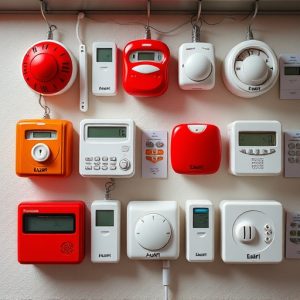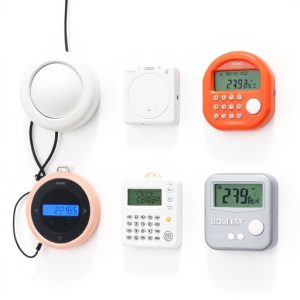Optimizing Safety: Best Personal Alarm Sound & Distance for Lone Workers
In today's digital era, with remote work becoming prevalent, safeguarding lone workers is cruci…….
In today's digital era, with remote work becoming prevalent, safeguarding lone workers is crucial due to their unique risks and limited supervision. Traditional emergency response methods often fail in these scenarios. Dedicated lone worker safety systems, featuring personal alarms with the best personal alarm sounds designed for maximum distance (50-100 meters), are vital tools. These alarms ensure prompt help when workers face dangers, even if they cannot communicate directly. Optimal personal alarm systems should include powerful, distinctive sounds, customizable settings, extended battery life, water resistance, and user-friendly activation buttons. The science behind acoustic alerts leverages sound to capture attention instantly, with studies showing that loud, sharp noises activate emergency response mechanisms from a distance. Choosing the best personal alarm requires focus on superior sound quality (85-120 decibels) and optimized distance up to 100 meters, with adjustable settings for varying environments. These systems have proven indispensable across diverse sectors, ensuring swift response times in emergencies, as illustrated by a case of a lone forester rescued from a bear attack.
In today’s diverse work environment, ensuring the safety of lone workers is paramount. With increasing numbers operating in remote or isolated settings, effective communication and alert systems are crucial. This article explores the vital role of safety alert systems for lone workers, focusing on personal alarms. We delve into key components, the science behind acoustic alerts, and best practices for choosing optimal sound and distance. Real-world applications highlight successful implementations, underscoring the importance of such systems in safeguarding our workforce.
- Understanding the Need for Lone Worker Safety Systems
- Key Components of an Effective Personal Alarm System
- The Science Behind Acoustic Alerts and Their Efficacy
- Best Practices for Choosing a Personal Alarm with Optimal Sound and Distance
- Real-World Applications: Success Stories of Lone Worker Protection
Understanding the Need for Lone Worker Safety Systems
In today’s digital era, where remote work and independent operations are increasingly common, ensuring the safety of lone workers has become a paramount concern. These individuals, often working unsupervised in isolated locations or dangerous environments, face unique risks that demand specific solutions. Traditional emergency response systems often fail to provide timely assistance due to their reliance on direct communication or visibility. Thus, implementing dedicated lone worker safety systems is essential to mitigate these risks effectively.
One critical component of such systems is the personal alarm, which serves as a lifeline for lone workers. When activated, these alarms emit distinct and powerful best personal alarm sounds designed to capture attention over significant distances. Whether it’s a loud beep or a specific audio signal, the chosen sound must be effective in alerting bystanders, fellow workers, or emergency services promptly. This feature is crucial as it enables immediate assistance, especially when the worker is unable to communicate their distress directly.
Key Components of an Effective Personal Alarm System
An effective personal alarm system for lone workers should have several key components. Firstly, it needs a loud and distinct best personal alarm sound that can cut through ambient noise, ensuring it’s heard even in bustling environments. The distance at which the alarm is audible is critical; it should be designed to alert nearby colleagues or emergency services from a reasonable range, typically around 50-100 metres, depending on the environment.
Additionally, the system should offer customizable settings for sensitivity and activation methods. This allows users to tailor the alarm to their specific needs and work environments. Features like long battery life, water resistance, and easy activation buttons are also essential for a reliable personal alarm system that provides peace of mind for lone workers.
The Science Behind Acoustic Alerts and Their Efficacy
The science behind acoustic alerts for lone workers focuses on leveraging sound as a powerful communication tool. When a worker is in distress, their personal alarm sounds off, emitting a distinct and high-intensity auditory signal designed to capture attention quickly. Studies have shown that loud, sharp noises can trigger the brain’s emergency response mechanisms, even from significant distances. This is crucial for lone workers who might be far away from immediate assistance.
The efficacy of acoustic alerts is evident in various scenarios. The best personal alarm sound should be both familiar and jarring to ensure it gets noticed. Distances play a vital role; the further the worker is from help, the louder and more distinct the alert needs to be. Effective alarms can be heard up to 50 meters or more away, depending on environmental factors, providing valuable time for assistance to arrive. This technology has proven to enhance safety, especially in industries where workers frequently operate alone, ensuring quick responses during emergencies.
Best Practices for Choosing a Personal Alarm with Optimal Sound and Distance
When selecting a personal alarm for lone workers, prioritizing sound quality and distance is paramount. The best personal alarm should emit a loud, high-pitched sound that can cut through ambient noise, ensuring maximum visibility in emergency situations. Ideally, it should meet or exceed industry standards for audible alert levels, typically around 85-120 decibels. This level of volume guarantees the alarm will capture attention swiftly.
Distance is another critical factor. A lone worker’s personal alarm should be effective within a radius of at least 50-100 meters, depending on environmental conditions like terrain and background noise. Consider devices that offer adjustable sound levels and distance settings to cater to different work environments. This flexibility ensures optimal safety for workers in varied scenarios.
Real-World Applications: Success Stories of Lone Worker Protection
In real-world scenarios, safety alert systems for lone workers have proven invaluable in various industries and environments. Construction sites, remote forests, and even indoor facilities like warehouses benefit from these innovative solutions. For instance, a construction worker equipped with a personal alarm device can quickly trigger an alert in case of an accident or emergency. The best personal alarm sound, when combined with excellent distance capabilities, ensures that help arrives swiftly.
Success stories abound where the timely activation of such systems has saved lives and prevented severe injuries. In one notable case, a lone forester used his personal alarm to signal a bear attack. The high-decibel sound alerted nearby park rangers, who rushed to his aid. This example highlights how effective best personal alarm sounds can be in distress situations, allowing workers to communicate their location accurately even over significant distances.
Lone worker safety should never be taken lightly, and implementing effective alert systems is a vital step towards ensuring their well-being. By understanding the unique challenges faced by these individuals and investing in advanced personal alarm systems, employers can significantly enhance response times during emergencies. The key lies in selecting alarms with optimal sound levels and coverage distances, as backed by scientific studies on acoustic alerts’ efficacy. Real-world success stories prove that these systems not only protect lone workers but also foster a sense of security and peace of mind, making them indispensable tools in today’s diverse work environments.


